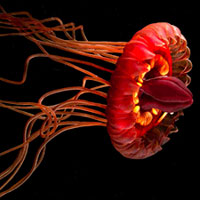June 19–September 12, 2010
The first-ever museum exhibition to explore the phenomenon of bioluminescence — an organism’s ability to produce its own light.
Visitors to Glow: Living Lights start their journey by investigating the chemical process that produces “cool” light. They then explore the world of light-producing terrestrial organisms like fireflies, glow worms and foxfire fungus before traveling on to the mid-ocean, where an estimated 90 percent of the animals produce light. Here visitors encounter alien-looking creatures like viper fish, which dangle a light lure to attract their next meal, and cookie cutter sharks, which earned their name from the cookie-size chunks of flesh they take out of unsuspecting prey in the dark. Visitors continue on to demonstrations of the interesting techniques and equipment used by scientists to study bioluminescence, and then explore the many benefits of this research — from helping to speed the study of cancer-fighting drugs to the detection of anthrax spores in public places.
CURATORS
Dr. Edith Widder of the Ocean Research and Conservation Association (ORCA) is an author on the subject and has been featured in a number of television and film projects, including specials on the Discovery Channel, National Geographic and PBS. Dr. James Case is a leading expert on fireflies and a research professor at the Marine Science Institute at the University of California, Santa Barbara, and is widely regarded as the “grandfather” of bioluminescence research. Joining Drs. Case and Widder as a curatorial consultant is Dr. Steven Haddock of the Monterey Bay Aquarium Research Institute. Glow: Living Lights is produced by Exhibit IQ.
Links
- Glow Educator's Guide (PDF)
- Flashers attract mates: How do we know?
- Firefly Watch - report your firefly sightings and help scientists track firefly populations!
- Photos from Glow lecturer Sönke Johnsen's Bahamas survey


